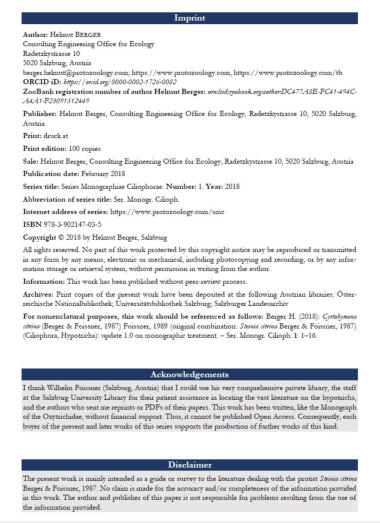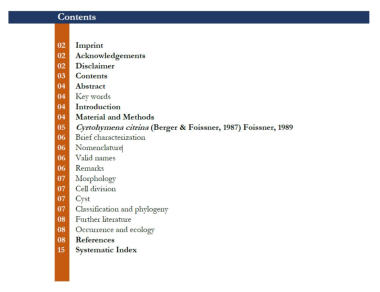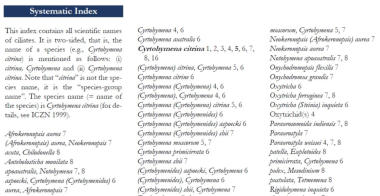NAVIGATION
ADDRESS
Technisches Büro für Ökologie
Consulting Engineering Office for Ecology
Radetzkystrasse 10
5020 Salzburg
Austria
CONTACT
office@protozoology.com
https://protozoology.com/tb or
https://www.protozoology.com
tel: 0662-27 64 08 (leave a message
on the answering machine)
fax: 0662-27 64 08-1
last update: 2025.03.19
About the Series Monographiae Ciliophorae
Important information and disclaimer At present, this series serves only to publish my own works which are mainly intended as guides or surveys to the literature of hypotrichous ciliates. Consequently, do not send a manuscript! No claim is made for the accuracy and/or completeness of the information provided in these works. The author (Helmut Berger) and publisher (Helmut Berger) of these papers is not responsible for problems resulting from the use of the information provided.Brief history of literature collection
In the early 1980’s I was invited by Dieter Matthes (Erlangen), editor of the Protozoenfauna 1 (Gustav Fischer Verlag), to write volume 6 of this series, the Hypotricha. It was planned to include all hypotrichs and euplotids in a single volume. Since that time I collected literature on these groups resulting in more than 7700 works which are now in my collection. Each of these works is indexed to (sub)species level (including varieties, forms), resulting in a literature database with likely more than 200.000 entries. Unfortunately, the major part of this “database” is non-electronic. So far, six books have been published based on this detailed literature collection, namely Berger (1999, 2001, 2006a, 2006b, 2008, 2011). Three further monographs are almost finished or in preparation (Berger 2018a, b, 2019). For the related projects by the Austrian Science Fund and the Austrian Academy of Sciences, see Projects. In addition, it was useful for some other books (e.g., Berger et al. 1997; Foissner et al. 1991, 1999, 2002) and papers (for complete list of publications see https://www.protozoology.com/sci/publications.htm#top).Brief overview about first works published in this series
The series starts with genera and species treated by Berger (1999). This book, which was not supported by the Austrian taxpayers, deals with the oxytrichids, a non-monophyletic group (as defined in this book) which was mainly characterized by the plesiomorphy “18 frontal-ventral- transverse cirri”. The preparation of this book consumed major parts of my leisure time between 1985 and 1999. Since several parts of this book are not very detailed (e.g., nomenclature, faunistics) and because many new papers on a significant number of “oxytrichid” species have been published since then, I update these species and genera step by step, starting with Cyrtohymena Foissner, 1989 (Berger 2018a, b, c). After the publication of almost 20 books (including Berger 2019a, b, 20??) with a total number of many thousand pages, I prefer the production of short papers. This has some advantages: (i) The works are available within weeks and months and not after 5-10 years; (ii) You can order those papers which are of interest for you; (iii) The content of such works can be easily updated.Why an own series?
The works published in the Series Monographiae Ciliophorae are basically “data sheets” on the species of hypotrichous ciliates, that is, they provide detailed, critical overviews about “all” papers dealing with a certain species, considering a time span of about 260 years (1758–2017). Such contributions, which are a kind of database, are usually not appropriate for the publication in journals like, for example, Acta Protozoologica, European Journal of Protistology, or The Journal of Eukaryotic Microbiology. Consequently, I make this valueable information available via the “in-house magazine” Series Monographiae Ciliophorae. Other examples of such “databases” are my booklets on the names and the literature on hypotrichs and euplotids (Berger 2001, 2006a). As in the many databases available in the www, no peer-review process is applied. In spite of that, the works pubished in the present series are carefully prepared, like my monographs (Berger 1999, 2006b, 2008, 2011). Of course, mistakes cannot be excluded, but this also applies to peer-reviewed papers. Since the works are not supported by a project or an institution (university, museum, etc.), they cannot be published Open Access. Consequently, each buyer of one or more works of this series supports the production of further works of this kind.Limited edition
The works published in the Series Monographiae Ciliophorae are of interest for only a small number of people. Thus, the edition is limited to about 50 to 100 print copies, depending on the species treated. Each copy has its own number and is signed by me. For net prices of works and total amount (including handling, postage etc.), see Published Numbers; for details on price (including shipping, tax, etc.), click here.Scheme of works
Each work has more or less the same structure composed of the following chapters: • Heading. The heading consists of two parts, namely the current name (above) and the original combination (ICZN 1999, see recommendation 51A for term; often also named basionym, a term not used in the ICZN 1999, but in botany), including authors and year. The original combination is mentioned in the heading because it never changes. By contrast, the current name is usually the combination most recently published. • List of synonyms. The list of synonyms contains all taxonomically and nomenclaturally important contributions, that is, the original description, all combinations, redescriptions, and other taxonomically important papers. Papers where solely molecular data are published are usually not included in the list; these studies can be found in the chapter phylogeny and classification (see below). Each entry consists of the following components: year of publication and name as written in the paper, including authors, year, and/or nomenclatural terms like, for example, comb. nov. (all these parts are in bold); the n-dash (–) separates the taxon from the bibliographic data of the work containing this name; author(s) of work; name of journal or (brief) title of book; volume of journal or book series; page number where description begins or where nomenclatural act is made (a page number with the letter K means a page where the taxon is mentioned in a key); figures and tables referring to taxon; in brackets, brief explanation of content, accession numbers of slides, problems, etc.). • The entry of the original description contains also the ZooBank registration number. Note that the registration in ZooBank (zoobank.org) is a prerequisite for the valid publication of a new taxon/nomenclatural act in online-only journals since 2012 (ICZN 2012, Article 8.5), that is, such works which do not contain the registration (or at least a hint that registration has occurred) in the work itself are not published in the sense of nomenclature and thus the taxa described therein are not valid. An example for such an invalid original description is Shao et al. (2014). The corrigendum, which represents now the original description, was published by Shao et al. (2017). • Brief characterisation. The brief characterisation is based on the original description (only when it contains relevant features) and other papers dealing with morphology (see list of synonyms). It is a summary of the main features and not an “improved diagnosis” or detailed description. The features are arranged as in my monographs. For details on morphology, see original description, redescriptions, and revisions mentioned in the list of synonyms. • Nomenclature. In the chapter nomenclature the species-group name is explained and nomenclatural problems are discussed. • Valid names. This chapter lists all names validly published including original author(s) and combining author(s) and years. The names are listed chronologically. • Remarks. In the remarks section, taxonomic topics and issues are discussed more or less detailed. • Morphology. This chapter is usually brief because containing only hints to the original description, redescriptions, and revisions. Since the page numbers are mentioned you can find the data rather easily in the various publications, which are sometimes rather voluminous. My monographs usually contain most or even all relevant figures published until that time. Later papers are mostly available as PDFs in the www and thus (almost) instantly accessible. The works published in the present series do not contain illustrations and micrographs; however, via the detailed hints in the work itself you can find the illustrations and micrographs very easily in the original publications or in revisions! • Cell division etc. Chapters on cell division, physiology, or other issues are optional, that is, only available when data on these topics have been published. • Classification and phylogeny. The classification and phylogeny section begins with a brief comment on the supposed phylogenetic position. When sequences are available the origin (direct submission or via a paper) is mentioned as indicated in NCBI data base. In addition, all papers using the sequence are listed. When more than one sequence is published, then the references are kept separate. • Further literature. In this chapter, papers are listed which cannot be assigned to other chapters. • Occurrence and ecology. The chapter occurrence and ecology provides a brief comment on the main habitats and the geographic distribution. Usually you will find a hint to the same chapter in the corresponding monograph (Berger 1999, 2006b, 2008, 2011) where most or even all records are considered in detail. In addition, “all” records not considered in the corresponding monograph are listed. In some cases the present chapter contains all records published so far, especially when the number of records in not very high or the presentation in the corresponding monograph not very detailed (Berger 1999). The records are arranged according to continents; within the continents, the countries are listed alphabetically. • References. The reference section contains all papers mentioned in the present study. Papers not dealing with the species treated are marked with an asterisk. • Systematic index. Each work contains a two-sided index (e.g., Cyrtohymena citrina; citrina, Cyrtohymena) to the scientific names. Works dealing with the type species (e.g., Berger 2018c) also contain a review of the genus, the key to the species, and a list of species which are misclassified in this genus or species indeterminata, nomina nuda, etc. 1 Five parts of the Protozoenfauna (PF) have been published, before the series was ceased: (1) Matthes D. (1988): Suctoria (Sauginfusorien). – PF 7/1, XI-XIII, 1-226, 307-309; (2) Guhl W. & Haider G. (1988): Urceolaridae (Peritricha). – PF 7/1: 227-306, 309; (3) Page F.C. (1991): Nackte Rhizopoda. – PF 2: 1-170, 291-297; (4) Siemensma F.J. (1991): Heliozoa. – PF 2: IX-XI, 171-297; and (5) Foissner W. (1993): Colpodea (Ciliophora). – PF 4/1: I-X, 1-798.References*
• Berger H. (1999): Monograph of the Oxytrichidae (Ciliophora, Hypotrichia). - Monographiae Biologicae, 78: i-xii, 1-1080. • Berger H. (2001): Catalogue of ciliate names 1. Hypotrichs. Verlag Helmut Berger, Salzburg. i- viii, 206 pages. • Berger H. (2006a): Bibliography of Hypotrichs and Euplotids (Ciliophora). Verlag Helmut Berger, Salzburg. i-viii and 425 pp. 6062 references. • Berger H. (2006b): Monograph of the Urostyloidea (Ciliophora, Hypotricha). - Monographiae Biologicae 85: i-xvi, 1-1304. • Berger H. (2008): Monograph of the Amphisiellidae and Trachelostylidae (Ciliophora, Hypotricha). - Monographiae Biologicae 88: i-xvi, 1-737. • Berger H. (2011): Monograph of the Gonostomatidae and Kahliellidae (Ciliophora, Hypotricha). - Monographiae Biologicae 90: i-xiv, 1-741. • Berger H. (2018a): Cyrtohymena citrina (Berger & Foissner, 1987) Foissner, 1989 (original combination: Steinia citrina Berger & Foissner, 1987) (Ciliophora, Hypotricha): update 1.0 on monographic treatment. – Series Monographiae Ciliophorae, Number 1, 1–16 • Berger H. (2018b): Six little-known Cyrtohymena species (Ciliophora, Hypotricha): update 1.0 on monographic treatment. – Series Monographiae Ciliophorae, Number 2, 1–? • Berger H. (2018c): Cyrtohymena Foissner, 1989 and Cyrtohymena muscorum (Kahl, 1932) Foissner, 1989 (Ciliophora, Hypotricha): update 1.0 on monographic treatment. – Series Monographiae Ciliophorae, Number 3, 1–? • Berger H. (2019a): Monograph of Euplotoides Borror & Hill, 1995 (Ciliophora, Spirotricha, Euplotidae). - Denisia, in preparation. • Berger H. (2019b): Monograph of the Keronopsidae, Uroleptidae, Rigidotrichidae, and some other groups (Ciliophora, Hypotricha). - Monographiae Biologicae ##: in preparation. • Berger H. (20??): Monograph of the Hypotricha (Ciliophora). Remaining taxa - Monographiae Biologicae ##: in preparation. • Berger H., Foissner W., Kohmann F. (1997): Bestimmung und Ökologie der Mikrosaprobien nach DIN 38410. Gustav Fischer, Stuttgart, Jena, Lübeck, Ulm. I-X and 291 pp. • Foissner W., Blatterer H., Berger H., Kohmann F. (1991): Taxonomische und ökologische Revision der Ciliaten des Saprobiensystems - Band I: Cyrtophorida, Oligotrichida, Hypotrichia, Colpodea. - Informationsberichte des Bayerischen Landesamtes für Wasserwirtschaft, 1/91: 1- 478. • Foissner W., Berger H., Schaumburg J. (1999): Identification and ecology of limnetic plankton ciliates. - Informationsberichte des Bayerischen Landesamtes für Wasserwirtschaft, 3/99: 1- 793. • Foissner W., Agatha S., Berger H. (2002): Soil ciliates (Protozoa, Ciliophora) from Namibia (Southwest Africa), with emphasis on two contrasting environments, the Etosha region and the Namib Desert. - Denisia 5: 1-1459. • ICZN (International Commission on Zoological No-menclature) (1999): International Code of zoological nomenclature. International Trust for Zoological No-menclature, London. 306 pp. • ICZN (International Commission on Zoological Nomenclature) (2012): Amendment of Articles 8, 9, 10, 21 and 78 of the International Code of Zoological Nomenclature to expand and refine methods of publication. Bull. Zool. Nom. 69: 161–169. • Shao C., Li L., Zhang Q., Song W., Berger H. (2014): Molecular phylogeny and ontogeny of a new ciliate genus, Paracladotricha salina n. g., n. sp. (Ciliophora, Hypotrichia). - The Journal of Eukaryotic Microbiology 61: 371-380. • Shao C., Li L., Zhang Q., Song W. & Berger H. (2017): Corrigendum to "Molecular phylogeny and ontogeny of a new ciliate genus, Paracladotricha salina n.g., n.sp. (Ciliophora, Hypotrichia) by Shao et al. 2014". - The Journal of Eukaryotic Microbiology, doi:10.1111/jeu.12418 *For a complete list of my publications, see https://www.protozoology.com/sci/publications/index.html. Send an informal e-mail (with your name) to berger.helmut @protozoology.com to get the username and password for the download of most works.
Imprint of number 1 (large)
Content of number 1 (large)
Introduction of number 1 (large)
List of synonyms of number 1 (large)
Brief characterisation of number 1 (large)
Classification of number 1 (large)








Occurrence and ecology of number 1 (large)

Literature of number 1 (large)

Systematic index of number 1 (large)
















